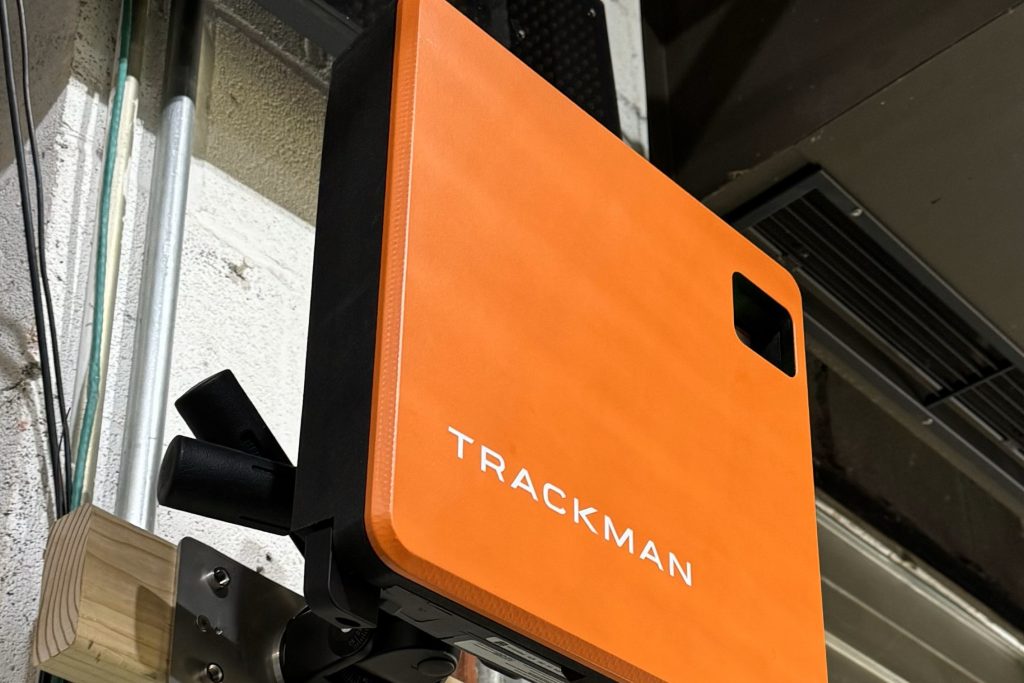
As many in the baseball world know, Trackman is arguably the best piece of technology when analyzing a pitcher and their pitch metrics. Trackman is a military grade radar that captures metrics such as velocity, spin rate, spin axis, tilt, release angles, approach angles, release height, extension, movement profiles, and more.
How to build your pitching arsenal with Trackman?
The way we use Trackman is to build pitch arsenals, based on a given athlete’s fastball and physical structure. Whether you are tall or short, a pronator or supinator, over-the-top or sidearm release, there is a way to maximize your pitch capabilities. We strive to create separation between pitches, making it difficult for hitters to identify what is coming at them on a pitch by pitch basis. In conjunction with creating separation, having consistency among movement profiles is just as important. Having smaller “clusters” means pitch breaks are similar pitch to pitch, as opposed to having scattered points on the movement plot.
Let’s dive into three of our high level athletes that have thrown recent mid-week Touch and Feel pens with us since the dawn of the high school season, and analyze their metrics.
Chris Sand – Up to 90 mph
Rutgers Commit Chris Sand boasts an elite pitch arsenal of 4SFB, CH, and SL. Being able to throw multiple pitches with the same movement consistently is key, especially as an athlete moves to the higher levels. In Chris’ case, he does just that. Below are Chris’ average metrics for each pitch type:
-
- 4SFB: 88-90 mph, 2500-2600 rpm, 16’ IVB, 11’ HB, -4.7° VAA
- CH: 82-84 mph, 1700-1800 rpm, 5’ IVB, 17’ HB, 2:30 Tilt
- SL: 76-78 mph, 2600-2700 rpm, 0’ IVB, -17’ HB, 0.5° VRA
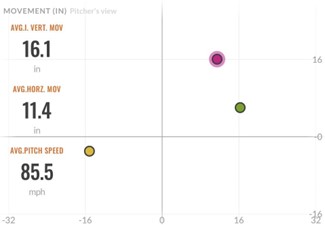
Chris does many things well in terms of his arsenal. He shows an elite Fastball that plays well up in the zone. We can identify this through his Vertical Approach Angle (VAA). VAA is how steeply up or down the ball enters the zone, reported as the angle in degrees, as the pitch crosses the front of home plate.
Remember that Vertical Approach Angle is dependent on location. Because VAA is the measurement as the ball enters the zone, the more positive the vertical carry of the pitch (IVB), the flatter the VAA is of that specific pitch. As for release speed, the harder the pitch is thrown and the quicker it is moving means there is less gravitational pull on it, which can create a rising fastball and a more effective VAA. Release Height and Extension are the two major variables that contribute to VAA. For example: Low Release Height and High Extension = Elite VAA. So why is VAA so important?
Each level’s average VAA, spin rate, velocity, and movement patterns don’t change when you go from high school to college to professional ball, but whiff rate and opposing batted ball profiles do. To put things in perspective, the average Major League Pitcher’s VAA is -4.8. Chris is right up there with some of the best in baseball, including Max Scherzer, who’s VAA is -4.78 degrees. As stated in his athlete highlight article, by continuing to work on his Torso Position at Ball Release, his arm slot will lower an inch or two, making the fastball even more elite when up in the zone.
As for the rest of Chris’s arsenal, his CH and SL are both ++. Both pitches are thrown with conviction and are hard to identify out of the hand. What Chris needs to work on is developing a harder off-speed pitch, such as a Cutter or a Gyro Slider. This will not only complement the rest of his repertoire, but it will keep hitters off balance, making them respect the fact that there are two off-speed pitches that will tunnel off of each other (The new Cutter/Gyro and Chris’ Slider).
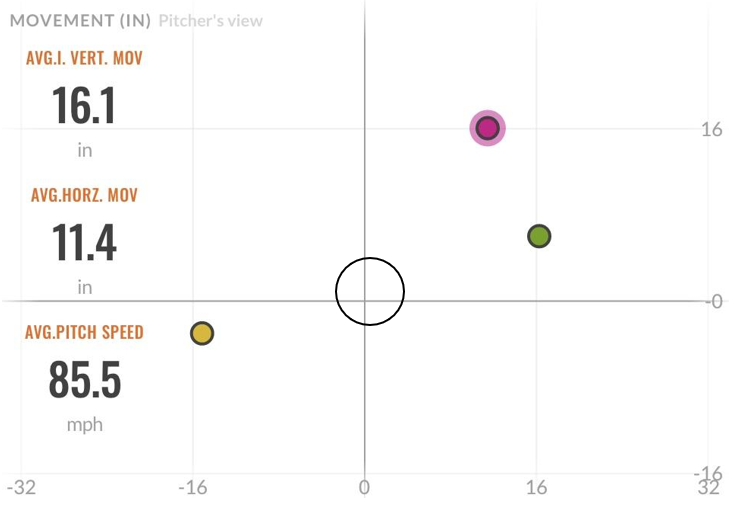
Nolan Geisler – Up to 92 mph
A lot of what I discussed with Chris earlier is similar for UMass Lowell Commit Nolan Geisler. Nolan also has an elite pitch mix which goes as follows:
-
- 4SFB: 89-91 T92 mph, 2200-2300 rpm, 14’ IVB, 14’ HB, -4.8° VAA
- SNK: 89-91 T92 mph, 2100-2200 rpm, 6.5’ IVB, 18’ HB, -7.3° VAA
- CH: 81-83 mph, 1400-1500 rpm, 4’ IVB, 18’ HB, 2:30 Tilt
- SL: 75-77 mph, 2200-2300 rpm, 0’ IVB, 18’ HB, 1.0° VRA
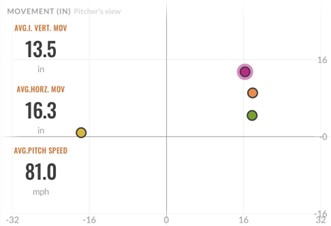
Just like Chris, Nolan has an elite 4SFB that will play well up in the zone due to his release metrics (++ extension with low release height). Where Nolan differs from Chris is his Sinker. Based on his arm slot, Nolan can throw an elite SNK that tunnels well with the 4SFB and his CH. Sporting a -7.3 VAA on his SNK makes it a “Bowling Ball Sinker” and will play great down in the zone, while his 4SFB will have success at the top rail of the zone. Then by mixing in the CH, he really is keeping hitters guessing.
Where Nolan can improve his arsenal is the same as Chris, by adding a Cutter or small Slider to the mix. There are currently 36 inches of separation horizontally between Nolan’s Slider and pitches discussed above. There needs to be something that will bridge the gap in his arsenal and a cutter/small slider at 84-86 mph is the perfect pitch. As stated before with Chris, it will not only complement Nolan’s arsenal, but it will keep hitters guessing the 1st, 2nd, and 3rd time through the order.
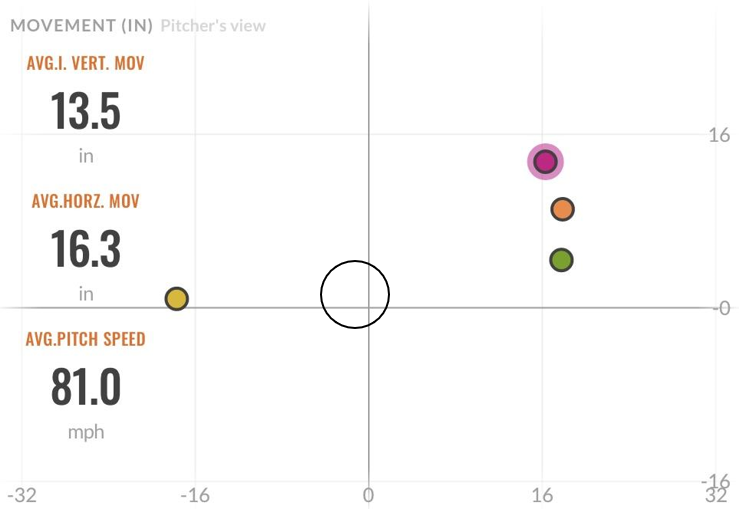
Reno Spagnoli – Up to 95 mph
Seton Hall Commit Reno Spagnoli is about as good as it gets at pitch movement in terms of separating his pitches. Below are Reno’s average metrics for each pitch type:
-
- 4SFB: 90-92 T95 mph, 2200-2300 rpm, 16’ IVB, 9’ HB
- CH: 81-83 mph, 1600-1700 rpm, 1’ IVB, 15’ HB, 3:00 Tilt
- CUT: 83-85 mph, 2500-2600 rpm, 2’ IVB, 0.5’ HB
- CB: 77-79 mph, 2600-2700 rpm, -8’ IVB, -8’ HB, 0.3° VRA
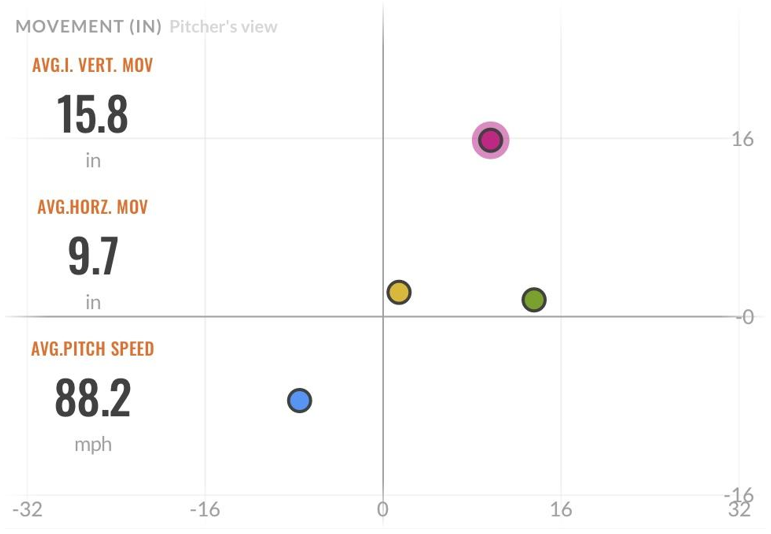
In terms of putting it all together, Reno has it figured out. All his pitches tunnel very well together after we tweaked his CB and added the Cutter this offseason. In terms of the Cutter (Yellow Dot), this is what we would like to see out of Chris and Nolan.
Breakdown
I’ve stated a few times in the pitcher metric breakdowns VRA, which is Vertical Release Angle. VRA is very similar to VAA, but Vertical Release Angle is how steeply up or down that the ball LEAVES THE PITCHER’S HAND. Why we evaluate VRA is because we do not want a high positive number. A high positive number (such as 3.0°) means the ball is popping out of the pitcher’s hand, so for Chris, Nolan, and Reno to all be sub 1.0° on their breaking balls is great.
Lastly, I’ve also mentioned Tilt a frequent number of times. Think of Tilt in terms of the clock and wrist position. Tilt and wrist position is what creates movement.
For example, 3:00 Tilt on a Changeup will result in 0’ IVB. Below 3:00 will add depth and above 3:00 will add hop. 9:00 Tilt on a Slider will also result in 0’ IVB. Below 9:00 Tilt will add depth and above 9:00 Tilt will have lift.
Each pitch type has a different tilt that would create movement and this is what we use to cue our athletes in terms of wrist position. Cues such as “Get to the side of it” or “Throw the outer half of the ball and rip the seam” will both put the wrist in a position to succeed on either a CH or SL in these examples.
Conclusion
While there is always room for improvement, i.e. killing vertical break or creating additional horizontal break, being able to make pitch by pitch adjustments and see exactly what the results say are crucial for an athlete’s development.
Trackman does just that.
Whether it is chasing a desired break, an improved release angle, or even an increase in spin, Trackman gives you the best representation of a pitcher’s arsenal in private sector training.
Pitch design is one of the most important, least talked about subjects in baseball. Having clean and repeatable mechanics are obviously at the forefront of our minds at RPP, but once we step on the mound, ensuring the athletes have big league level stuff at the professional, collegiate, and high school level is just as important.
Our jobs as pitchers are to attack and get outs. Taking into consideration how the athlete is built (size, release metrics, wrist orientation) and what their Fastball metrics look like, we can truly evaluate their repertoire and make them the best pitcher on the field.
Glossary
-
- Velocity: Maximum speed of a given pitch on its way to the plat
- MPH: Miles Per Hour; Units used to measure a pitcher’s velocity
- Spin Rate: Rate of Spin the ball has after it is released
- RPM: Revolutions Per Minute: Units used to measure a pitcher’s spin rate
- IVB: Induced Vertical Break; How much the ball is moving upward as it travels from ball release to home plate, created from backspin and topspin
- HB: Horizontal Break: How much the ball is moving laterally as it travels from ball release to home plate, created from sidespin
- VAA: Vertical Approach Angle; The angle at which a given pitch crosses the front of home plate
- VRA: Vertical Release Angle; The angle at which a given pitch is release from the pitcher’s hand
- Spin Efficiency: How much a given pitch is spinning as it travels to the plate (100% Spin Efficiency is True Backspin, 0% Spin Efficiency is Gyroscopic Spin)
- Spin Axis: Direction in which the ball is spinning, reported in degrees of tilt on a clock
- Tilt: Spin Axis converted into clock time, the ball will break in the direction the clock is pointing
- Release Height: Vertical distance of the ball above home plate when the pitch leaves the pitcher’s hand
- Extension: Distance towards home plate from which the pitcher releases the ball relative to the rubber
By Matthew Hartshorn (Pitching Coordinator)
You live too far to train with us in-house at RPP? You can now train with us on a REMOTE basis.


